Effect of Human Genetic Variability on Gene Expression in Dorsal Root Ganglia and Association with Pain Phenotypes
Marc Parisien1, Samar Khoury1, Anne-Julie Chabot-Doré1, Susana G. Sotocinal2, Gary D. Slade3,4, Shad B. Smith3,5, Roger B. Fillingim6, Richard Ohrbach7, Joel D. Greenspan8, William Maixner3,5,9, Jeffrey S. Mogil1,2, Inna Belfer1,10,*, Luda Diatchenko1,10,11,*
Link to Cell Reports Paper
- Supplementary Table 1
eQTL quality control, imputation, and discovery. Related to Figure 1. (a) Pre- imputation statistics. The total number of SNPs is broken down into four classes: those which did not pass QC filters, those with high missing genotyping rate, those with low minor allelic counts and those which depart from the Hardy-Weinberg equilibrium. (b) Post-imputation statistics. After imputation, total of ~82 million SNPs was detected (column B). After applying QC filters, there were 4.9 million SNPs left (column C). For comparison, post-imputation (column E) and pre-imputation (column F) SNP counts, corrected for linkage-disequilibrium, are compared to assess the gain (column G) in genotyping density following the imputation. (c) Statistics for DRG eQTLs. The number of tests that were performed to detect gene-level cis-acting, gene-level trans-acting, exon- level cis-acting and exon-level trans-acting eQTLs in DRG. The threshold p-values calculated are shown at 5% and 1% FDR for cis-acting and trans-acting eQTLs, respectively. (d) Cis-acting, gene-level DRG eQTLs. FDR 5%. (e) Gender-specific, female-only. (f) Gender-specific, male-only. (g) Cis-acting, exon-level DRG eQTLs. FDR 5%. (h) Trans-acting, gene-level DRG eQTLs. FDR 1%. (i) Trans-acting, exon- level DRG eQTLs. FDR 1%.
- Supplementary Table 2
eGenes in DRGs, blood and brain. Related to Figure 1. eGenes for each tissue can be found in 1-way lists. eGenes lists shared by two (two 2-way) or common to all three (one 3-way) tissues are also included. Pathway Studio analyses for enrichment of GO term “biological process” are adjoined. Statistically significant P-values (Bonferroni threshold of 0.05 / number of rows) are highlighted in yellow.
- Supplementary Table 3
(a) Neuronal versus non-neuronal (NoN) mouse gene expression corresponding to human DRG eGenes. Related to Figure 1. Neuronal cell types include: NF, NP, PEP and TH cluster of cells, where the NF cluster of cells expresses neurofilament heavy chain and parvalbumin, NP - expresses nonpeptidergic nociceptors, PEP expresses peptidergic nociceptors, and TH expresses tyrosine hydroxylase. (b) Master eGenes that are also DRG eGenes. The master eGenes list is derived from a previous analysis of eQTLs in 53 tissues. DRGs master eGenes are indicated.
- Supplementary Table 4
Lists of DRG eQTLs corresponding to SNPs reported to be associated with diseases or related pathological phenotypes using the NHGRI catalog. Related to Figure 4. The lists also include DRG eQTLs overlapping with those in blood and/or brain, as well as excluding blood and/or brain eQTLs.
- Supplementary Table 5
SNPs associated with pain phenotypes that are eQTLs in DRGs. Related to Figure 5. (a) In targeted association studies. (b) In genome-wide association studies.
- Supplementary Table 6
Genes commonly implicated in pain pathways. Related to Figure 5. The list is made from several sources: Algynomics’ Pain Panel V2, Pain Research Forum’s pain gene resource, and Amigo’s GO term 0019233. DRG eQTLs corresponding to pain genes. The eQTLs are cis-acting, at the gene- and at the exon-level.
- Supplementary Table 7
Comparison of DRG eQTL and OPPERA cohort GWAS results. Related to Figure 7. The lists represent SNPs that show combined P-value-weighted ranked-based scores between SNPs of selected phenotypes and eGenes for which these SNPs are eQTLs for in DRG. Combined scores highlighted in yellow are genome-wide statistically significant at FDR 1% level. Phenotypes are: 1). TMD - Temporomandibular Disorders; 2). LBP- Low Back Pain; 3). PPT- pressure pain threshold; 4). Mech- mechanical pain threshold; 5). Heat Pain Thresh - QST heat pain threshold; 6). Heat Pain Toler - QST heat pain tolerance. Column abbreviations are: PHENO_B, the association’s beta with the GWAS’ phenotype; PHENO_P, the association’s P-value with the GWAS’ phenotype; PHENO_S, the association’s S-score with the GWAS’ phenotype; EQTL_B, _P, and S are same as for PHENO_B, _P and _S, respectively, for DRG eQTLs. COMBINED_S is the combined association’s S-score for the GWAS and the eQTL studies.
|
- DRG_matrix_eQTL.tar.gz (filesize: 866,552,124; md5sum: 2864c40ec03afdc83efbf9ba418e218e)
This UNIX tarball contains input files for matrix_eQTL in order to perform your own eQTL analyses in human dorsal root ganglions:
- genotype data
- phenotype data (gene- and exon-level probe intensities)
- positions of transcription start sites (TSS) for tested genes
- positions of exon boundaries for tested exons
- covariates informations (age, gender, 2 PCA, etc)
* all files are human-readable, but UNIX-formatted text files.
|
- Alan Edwards Centre for Research on Pain, McGill University, Montréal, QC H3A 0G4, Canada
- Department of Psychology, McGill University, Montréal, QC H3A 0G4, Canada
- Center for Pain Research and Innovation, University of North Carolina at Chapel Hill, Chapel Hill, NC 27599, USA
- Department of Epidemiology, University of North Carolina at Chapel Hill, Chapel Hill, NC 27599, USA
- Department of Anesthesiology, Center for Translational Pain Medicine, Duke University, Durham, NC 27708, USA
- Department of Community Dentistry and Behavioral Science, University of Florida, Gainesville, FL 32611, USA
- Department of Oral Diagnostic Services, University at Buffalo, Buffalo, NY 14228, USA
- Department of Neural and Pain Sciences, Brotman Facial Pain Clinic, University of Maryland Dental School, Baltimore, MD 21201, USA
- Department of Pharmacology, University of North Carolina at Chapel Hill, Chapel Hill, NC 27599, USA
- These authors equally contributed to this work
- Lead Contact
- * Correspondence should be addressed to: belferinna/at/gmail.com, luda.diatchenko/at/mcgill.ca
|

